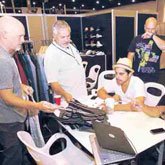Rough Surf
Tough times are making it harder for surf’s indie brands to break in.
For the once-freewheeling surf and skate fashion market, it has become increasingly tough for new and independent brands to find a way into the industry; the current economic situation might squeeze out new brands’ fresh ideas and hurt the entire industry, according to industry observer Shaheen Sadeghi.
“If the industry is to really thrive, we need young innovators to come in with new services and new approaches,” said Sadeghi, chief executive of Costa Mesa, Calif.–based specialty retail developer Lab Holding and a former president of Quiksilver.
Traditionally, gutsy new brands found a channel for their innovative fashions and styles in independent surf boutiques. However, a shrinking credit market and increasingly cautious retailers are proving to be high hurdles for many up-and-coming brands looking to break into a business known for the unconventional styles of pioneering brands such as RVCA, Volcom, Billabong and Quiksilver.
At the Aug.13–15 run of Action Sports Retailer, the leading surf trade show on the West Coast, an estimated 20 percent of exhibiting brands were new or new to the show, according to Andy Tompkins, vice president of ASR. A decade ago, half of the trade show floor was composed of new and independent brands, Tompkins said. New additions to ASR, such as Class@ASR, feature new brands. It is a separate show, offering more fashion-inspired brands for stores that carry surf and fashion, said Class founder Jason Bates. More than 30 percent of Class@ASR exhibitors were brands that typically offer fashion with surf and skate roots, Tompkins said. Consolidation and closures
The current economic downturn has created an almost impossible situation for new brands, Tompkins said. Retailers want to be the one to introduce a new, innovative brand. But it is hard for them to take a risk. An unforgiving economy has made them increasingly cautious about the brands they stock, according to Dean Quinn, co-founder of O’Quinn, a Huntington Beach, Calif.–based surf/skate and music company.
“When shops are scrambling [and] just trying to make it, they are not willing to try new brands,” Quinn said. “They might not be happy with big guys, but they can’t take a chance on small guys to make those dollars; it’s just business. When business is good and booming, they are open to new things.”
The retail landscape is shrinking. Many surf and skate companies have been developing retail divisions devoted exclusively to their brands. Earlier this year, surf giant Billabong purchased independent surf chain Becker Surf & Sport, and Anaheim, Calif.–based surf retailer Beach Bums went out of business. What remains is just a handful of independent surf stores that will retail new brands in Southern California, the cradle of the surf industry.Indie advantage
For independent retailers, new brands offer a competitive edge, said D. Nachnani, president of Coastal Edge, a 10-store chain based in Virginia Beach, Va., and a co-chair of the North Carolina–based trade group Board Retailers Association. Even in a bad economy, Nachnani contends, consumers want to see something fresh and new, and shops with new brands become a destination for consumers.
Nachnani devotes 10 percent of his floor space to new brands. Still, 80 percent of his stores’ business comes from sales of surf’s and skate’s most dominant brands, such as Billabong, Volcom, Vans, O’Neill and Hurley.
For some new and independent brands, big department stores and larger specialty stores are proving to be unlikely allies, said surf designer Quinn. The bigger retail players are seeking a competitive edge over branded shops and retail chains dominated by the big surf manufacturers. “The bigger department stores have been more willing to try new brands,” Quinn said. It might turn into a boost for new brands. “They have the floor space. They have buying power,” he said of the department stores, such as Macy’s and Nordstrom, that have sold the O’Quinn line. He said larger specialty stores, including Pacific Sunwear and Tilly’s, have been more open to picking up new and independent brands compared with beachside surf and skate shops, once the reliable destinations for new brands.Small opportunities
Despite the challenges, there are benefits to being a small, independent company, said Adel Kamil, principal of Costa Mesa, Calif.–brand Fyasko. With no boards of directors or stockholders to answer to, small, independent companies can react to changes in the market with a speed that larger companies cannot muster, Kamil said.
New, independent brands also do not have to work against the burden of maintaining an image or an identity often created by years of successful business for the big companies, said Frank Delgadillo, founder of 2-year-old Costa Mesa, Calif.–based brand Comune. Small, independent brands will have an easier time bringing something new to market. “I can compete on design,” Delgadillo said.
Lab Holding’s Sadeghi said the industry needs to do a better job of nurturing and investing in brands. “The powers that be must give more opportunities to new brands to keep the industry young,” he said.
Larger companies, such as Sole Technology Inc., said they support the emerging designers through internships and collaborations. “The internship program gives young designers a firsthand experience with Sole Tech’s apparel brands Altamont, etnies, eacute;S, Emerica and ThirtyTwo,” said Diem Culley, vice president of apparel for Sole Tech, based in Lake Forest, Calif.
“Our collaborations with young designers give them the opportunity to work with our established brands and open them up to larger distribution channels.”
Perhaps one of the best opportunities for up-and-coming designers will be generational change, Quinn said.
“The beauty of our industry [is] it’s always changing; there’s always an opportunity to grow,” Quinn said. “The action-sports kid is always growing up. There’s a new generation that does not want to wear what is in his dad’s closet. He wants to wear something different from what is being worn [by the masses].”

























